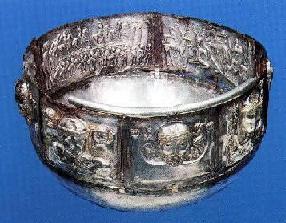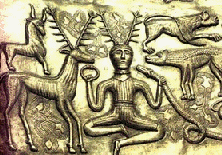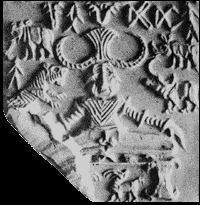|
Page < 1 2 3 4 5 6 7 8 9 10 11 12 13 14 15 >
Conclusion
In the words of author Michel
Danino: " With the distorting glass which the Aryan
invasion theory imposed on India's past now shattered, it is only a
matter of time before all the pieces are removed. One point now
established is the antiquity of the Veda. Though Indian tradition
and seers always held the Veda to be "many thousands of years
old," Max Muller and his school brought this down to 1200-1000
B.C. But the Vedic nature of the Indus-Sarasvati civilization and
the presence of the Vedic people along the Sarasvati in full flow
now pushes this date back to at least 2500-3000 BC. That would have
come as no surprise to Voltaire,
who remarked with much commonsense:
"It does not
behove us, who were only savages and barbarians when these Indian
and Chinese peoples were civilized and learned, to dispute their
antiquity."
The discovery of Dr.
Subhash
Kak, (professor of electrical and computer engineering at
the Louisiana State University), of an astronomical code embedded in the Rig-Veda has
led to new insights in this field; it showed that the ancient Rishis
knew the distance between the Sun and the Earth to be about 108
times the Sun's diameter (the same with the Moon's distance from the
Earth); they had also observed the periods of five planets (Mercury,
Venus, Mars, Jupiter and Saturn), and determined the solar year to
last between 365 and 366 days - all this several thousand years
before similar knowledge showed up in Egypt, Babylonia or Greece.
Mathematics, astronomy, language,
script, and a perennial culture. That is exactly what the famous
U.S. historian Will Durant meant
when he wrote in the 1950s:
"India was the
motherland of our race, and Sanskrit the mother of Europe's
languages: she was the mother of our philosophy; mother, through the
Arabs, of much of our mathematics; mother, through the Buddha, of
the ideals embodied in Christianity; mother, through the village
community, of self-government and democracy. Mother India is in many
ways the mother of us all."
Sources for this chapter :
The Invasion That Never Was
- By Michel Danino and Sujata
Nahar
In
Search Of The Cradle of Civilization: New Light on Ancient India
- By Georg Feurerstein, Subhash Kak & David Frawley
The Story of Civilization:
Our Oriental Heritage - By Will Durant
Colonial
Indology: Sociopolitics of the Ancient Indian Past - By Dilip K. Chakrabarti
Proof
of Vedic Culture's Global Existence - By Stephen Knapp
The
Genius of India - By Guy Sorman ('Le Genie de
l'Inde')
***
The rest
of the chapter begins - Aryan
Invasion Theory
For more information please
read the articles in the link listed below:
Articles on Aryan invasion theory
Origins
of Vedic Civilization - By Kenneth Chandler
Voice of India
http://www.voi.org/general_inbox/Kazanas/ejvs7_3.pdf
Top of Page
 Did You Know? Did You Know?
Gundestrup Cauldron
 In 1891, a huge silver bowl containing seven decorated plates was
unearthed in a peat bog in Denmark dates to 150 BC. Apparently it
shows strong evidence -- including goddess-images similar to Lakshmi
and Hariti and a god-image similar to Vishnu -- of cross-cultural
connections between Indic civilizations and those of far northern
Europe. Dr. Subhash Kak (professor
of electrical and computer engineering at the Louisiana State
University) has
noted the apparent connections between Celtic/Druidic pre-Christian
cultures of Europe and Hindu practices in his book, In
Search Of The Cradle of Civilization: New Light on Ancient India
- By Georg Feurerstein, Subhash Kak & David Frawley
In 1891, a huge silver bowl containing seven decorated plates was
unearthed in a peat bog in Denmark dates to 150 BC. Apparently it
shows strong evidence -- including goddess-images similar to Lakshmi
and Hariti and a god-image similar to Vishnu -- of cross-cultural
connections between Indic civilizations and those of far northern
Europe. Dr. Subhash Kak (professor
of electrical and computer engineering at the Louisiana State
University) has
noted the apparent connections between Celtic/Druidic pre-Christian
cultures of Europe and Hindu practices in his book, In
Search Of The Cradle of Civilization: New Light on Ancient India
- By Georg Feurerstein, Subhash Kak & David Frawley
According to him, Indic people were
apparently present in Palestine, Turkey, Babylon in the 2nd
millennium BCE. The names of the ruling dynasties of these places
and some Sanskritic inscriptions tell us this. The father of the
beautiful Nefertiti, Queen of Egypt, was a king of the Near East
named Tusharatha or Dasharatha.
The Puranas also say an Indian tribe
called the Druhyus emigrated West. Whether they emigrated all the
way to Europe, we cannot say. What is likely to have happened is
that an Indic element became the political and religious aristocracy
in many countries, all the way up to Europe. This may also explain
the parallels between Indian and European mythology.
(source: 'Our
school books talk about Socrates, Plato and Aristotle but don't
mention Yajnavalkya, Panini and Patanjali' - Rediff.com)


Cernunnos on the Gundestrup
image Pashupati - Yoga-like
posture
Watch
Scientific
verification of Vedic
***
Pashupati, Lord Shiva is the friend
of animals. This indicates that he must have been a common deity of
pre-Christian Europe. (For more refer to Indian
Paganism).
The
image of the Pashupati seal and of the same Yogi on the Gundestrup
Cauldron from Western Europe shown on the left tells the story of the
Aryan Invasion and the nineteenth century discipline called Indology that
created the theory. The Pashupati seal from India is nearly five thousand years
old, while the Gundestrup Cauldron was made a little over two thousand years
ago.
This
means: while scholars have been telling us about an 'invasion' of Indo-Europeans
from Eurasia to India, what evidence there is tells us exactly the opposite— a
recorded movement in ancient times from India to West Asia and Europe.
(source: Unraveling
of the Aryan Invasion Myth
)


Page < 1 2 3 4 5 6 7 8 9 10 11 12 13 14 15 >
|